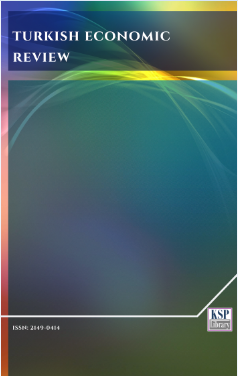Intertemporal modeling of the current account
Abstract
Abstract. This paper explores the long-run current account to GDP ratio in the present value model framework (PVMCA). Firstly, we use Euler equation at macro level to identify a general equation of the per capita current account to GDP. Secondly, through the overlapping generations model we determine the equation of per-capita CA using relevant variables, and discuss the empirical validity of the PVMCA via the quasi-elasticity of CA-to-GDP with respect to the per capita growth rate of output and consumption. We show that the elasticities of CA-to-GDP to per-capita output and ant to per-capita consumption growths interact in opposite paths, meaning that a higher growth rate of consumption tomorrow involves more saving yesterday and brings up a positive current account balance.
Keywords. Current account, Consumption, Intertemporal Model, Per-capita GDP, Quasi-elasticity.
JEL. E10, E20, F40.
Keywords
References
Aizenman, J., & Sun, Y. (2010). Globalization and the sustainability of large current account imbalances: Size matters. Journal of Macroeconomics, 32(1), 35–44. doi. 10.1016/j.jmacro.2009.11.001
Bellman, R.E., (1957). Dynamic Programming. Princeton University Press, NJ. Republished 2003: Dover.
Bertola, G., Foellmi, R., & Zweimuller, J. (2006). Income Distribution in Macroeconomic Models. Princeton University Press.
Blanchard, O.J., & Giavazzi, F. (2002). Current account deficits in the Euro Area: The end of the Feldstein-Horioka Puzzle?, Brookings Papers on Economic Activity, 33(2), 147–86.
Cerrato, M., Kalyoncu, H., Naqvi, N.H., & Tsoukis, Ch. (2015). Current accounts in the long run and the intertemporal approach: A panel data investigation. The World Economy Journal, 38(2), 340–359. doi. 10.1111/twec.12152
Corsetti, G., & Müller, G.J. (2006). Twin deficits: Squaring theory, evidence and common sense. Economic Policy, 21(48), 597-638. doi. 10.1111/j.1468-0327.2006.00167.x
Chinn, M.D., & Prasad, E.S. (2003). Medium-term determinants of current accounts in industrial and developing countries: An empirical investigation. Journal of International Economics, 59(1), 47–76. doi. 10.1016/S0022-1996(02)00089-2
Gourinchas, P.O., & Parker, J.A. (2002). Consumption over the life cycle. Econometrica, 70(1), 47-89. doi. 10.1111/1468-0262.00269
Hoffmann, M. (2013). What drive China’s current account?, Journal of International Money and Finance, 32, 856-883. doi. 10.1016/j.jimonfin.2012.07.005
Jordà, Ò., Schularick, M., & Taylor, A.M. (2011). Financial crises, credit booms, and external imbalances: 140 Years of lessons. IMF Economic Review, 59, 340-378. doi. 10.1057/imfer.2011.8
Kano, T. (2008). A structural VAR approach to the intertemporal model of the current account. Journal of International Money and Finance, 27(5), 757–779. doi. 10.1016/j.jimonfin.2008.04.003
Karras, G. (2009). Demographic change and the current account: Theory and empirical evidence. Journal of Economic Asymmetries, 6(1), 1-14. doi. 10.1016/j.jeca.2009.01.002
Lee, J., & Chinn, M.D. (2002). Current account and exchange rate dynamics in the G-7 countries. IMF Working Paper, No.02/130. [Retrieved from].
Obstfeld, M., & Rogoff, K. (1996). Foundations of International Macroeconomics. MIT Press, Cambridge.
Otto, G. (1992). Testing a present-value model of the current account: Evidence from US and Canadian time series. Journal of International Money and Finance, 11(5), 414-430. doi. 10.1016/0261-5606(92)90009-M
Sachs, J. (1982). Aspects of the current account behavior of OECD economies. NBER Working Papers. No.859. doi. 10.3386/w0859
Sandri, D. (2011). Precautionary savings and global imbalances in World general equilibrium. IMF Working Paper, No.11/122. [Retrieved from].
Sheffrin, S.M., & Woo, W.T. (2000). Present value tests of an intertemporal model of the current account. Journal of International Economics, 29(3–4), 237–253. doi. 10.1016/0022-1996(90)90032-H
Souki, K., & Enders, W. (2008). Assessing the importance of global shocks versus country-specific shocks. Journal of International Money and Finance, 27(8), 1420-1429. doi. 10.1016/j.jimonfin.2008.07.002
Stocky, N.L., & Lucas, R.E. (1989). Recursive Methods in Economic Dynamics. Cambridge, MA: Harvard University Press.
Yang, T., Zhang, D., & Shaojie, J.Z. (2010). Why are savings rates so high in China? Hong Kong Institute for Monetary Research. Working Paper, No.31. [Retrieved from].
DOI: http://dx.doi.org/10.1453/ter.v6i3.1936
Refbacks
- There are currently no refbacks.
.......................................................................................................................................................................................................................................................................................................................................
Turkish Economic Review - Turk. Econ. Rev. - TER - www.kspjournals.org
ISSN: 2149-0414
Editor: [email protected] Secretarial: [email protected] Istanbul - Turkey.
Copyright © KSP Library




